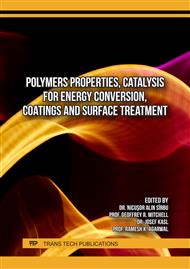p.19
p.25
p.31
p.41
p.53
p.59
p.69
p.79
p.85
Examination of the Need for Pre-Heating in Case of Hardfacing on S1100QL Steel
Abstract:
Using high-strength steels as substrates for hardfacing has become more and more influential over the years. The usage of high-strength steels started with S690QL steel, but nowadays the S1100QL is also applied as a substrate. Several applications can be found in the construction and demolition fields where the dynamic loading occurs beside the abrasive loading. To withstand this complex loading, the high-strength steel substrates are hardfaced by special welding wires with good wear resistance. In case of welding this type of material requires pre-heating especially for thick plates and requires very strict welding technology and necessary to adjust the right t8/5 cooling time for good results. The pre-heating can be very costly in case of hardfacing because of the relatively large surfaces and production time is also increasing. Additionally, in case of S1100QL steel, only softening happens in the heat-affected zone, and in most cases, it is necessary to minimize this effect to reach the highest strength. Previous investigations highlighted the effect of heat input on the softening, but pre-heating is always applied. Recent research focused on the need for pre-heating during hardfacing on S1100QL steel. Specimens were made with and without pre-heating using the same technological parameters and circumstances. Macroscopic and microscopic tests were performed on the hardfaced specimens to check the dimensional and microstructural differences. Then Vickers hardness measurements are performed on several points which resulted hardness maps on both cases. The subzones of heat-affected zones are identified with the help of hardness maps, and a comparison was made. The hardness results show remarkable differences in different subzones between the pre-heated and not pre-heated specimens. Hardened parts are not found in the heat-affected zones, but less softening happens with the not pre-heated technology.
Info:
Periodical:
Pages:
69-78
Citation:
Online since:
November 2025
Authors:
Keywords:
Price:
Сopyright:
© 2025 Trans Tech Publications Ltd. All Rights Reserved
Share:
Citation:


